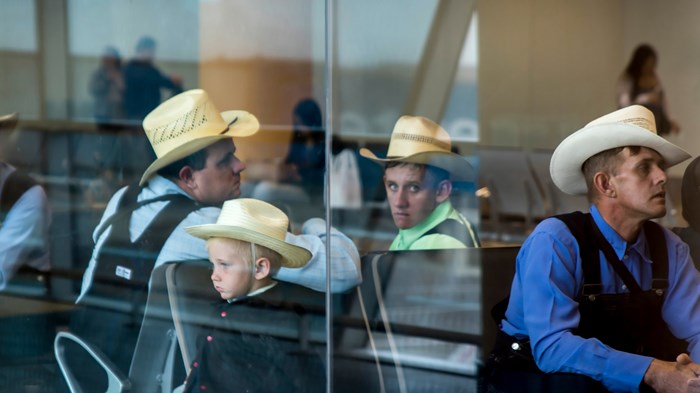
The well-kept lawns and exquisitely maintained houses in the town of Filadelfia could be part of any prosperous neighborhood in Europe or North America. They’re actually in rural Paraguay and most belong to conservative Mennonite communities. Known for their traditional way of life and pacifist convictions, in recent decades they have been settling across Latin America.
Paraguay, a landlocked South American country, is home to one of Latin America’s largest Mennonite communities. In a country of just six million around the size of California, Paraguayan Mennonites are particularly prominent as some of the largest landholders, as well as dominant in dairy and agricultural industries.
Arriving in Latin America just a century ago from Canada, the US, and Europe, the Mennonite experience is marked by frequent migration—and believers’ ability to put down roots and sustain their culture.
“I think it’s fair to say that there’s always been an impact everywhere the Mennonites have arrived,” said Delmer Wiebe, a Mennonite theologist who grew up near Filadelfia. “A highly developed work ethic has always left deep traces and brought many changes. God has blessed the effort. And that blessing has often been transformed into social and community aid.”
Low German-speaking Mennonites, as a socioreligious community, trace their origins back to 16th-century Western Europe. Not be mistaken for the Amish, who are also who are also Anabaptist, the Mennonites are named after Dutchman Menno Simons (1496–1561) and emerged in the wake of the Protestant Reformation, coalescing around ideals of nonviolence, adult baptism, and separation from worldly temptations.
As they moved from the Netherlands to Germany to Ukraine, Mennonites stuck to the now-archaic Low German language while escaping mandates to serve in various countries’ militaries, swear civil oaths, and join national education systems. Today, across North and South America, Mennonites have found refuge and thrive in several countries.
In Latin America in particular, Old Order Mennonites have settled in countries where social customs remain closer to their own conservative values. Some Mennonites in the US also continue to live traditionally while others are fully in the mainstream when it comes to technology and lifestyle. (In recent years, these Mennonite churches have been split by debates over same-sex marriage and other issues which have not affected Old Order communities in Latin American countries or in the US.)
The most conservative Mennonite colonies reject the use of rubber tires on tractors, electricity, and telephones, among other things. More progressive colonies, particularly in Paraguay, find it normal to own smartphones, TV sets, or pickup trucks. Diversity sometimes is found within colonies, with some members having starkly opposed views on education, labor, the use or rejection of the Spanish language, and more generally, ties with the outside world.
Scholars believe Mexico has the largest number of Mennonites in Latin America, although expansion there has been limited by conflicts over access to water resources. As a percentage of the total population, communities in Paraguay, Bolivia, and Belize are more significant, and they are predominantly visible in the countryside.
According to the Mennonite World Conference (MWC), 10 percent of the 2.13 million people belonging to churches rooted in the 16th-century Radical Reformation in Europe are based in Latin America and the Caribbean. However, this number does not include some of the most traditionalist groups, like Old Colony Mennonites and Old Order Mennonites, who make up many of the Latin American communities and which do not organize with the MWC, according to Karla Braun, a MWC spokeswoman.
The Mennonite expansion into Latin America started in the 1920s, when a group of Mennonites left the prairies of Manitoba for the deserts of Northern Mexico, Yann le Polain de Waroux and his coauthors wrote in their paper “Pious Pioneers: the expansion of Mennonite colonies in Latin America.”
Since then, Mennonites have created over 200 agricultural colonies across Latin America, spanning nine countries and seven biomes. Le Polain and his team’s calculations show that Mennonite colonies today cover an area exceeding that of the Netherlands, having expanded through the conversion of uncultivated land to agriculture in remote areas.
In Belize, 14 Mennonite colonies account for a non-irrelevant percentage of the population. The tiny country of 400,000 saw its first Mennonite settlers in 1955—Mexican communities looking to escape calls for stricter control of the group within that country.
But by the 1970s, many Belize Mennonites were already moving to Paraguay and Bolivia, fearful of creeping modernization and land scarcity.
In his paper, le Polain identified 65 Mennonite colonies in Mexico, the first Latin American country to open its borders to the group, and even more colonies (90) in Bolivia, where the first Mennonite settlement was founded in 1954. There, believers found land and an accepting attitude by the local authorities, which has allowed some groups to stick closer to their original roots.
“In Bolivia, the largest Mennonite communities are very conservative,” said Rebecca Janzen, a University of South Carolina scholar who has studied Mennonite colonies in the region and has relatives in several. “The largest communities there don’t learn Spanish, they don’t use electrical tech. … In Mexico, there are some people who attended university; in Bolivia, that’s much rarer.”
The isolation of Mennonites in Bolivia, in fact, contributed to a series of dramatic rapes that wracked one of their communities, Manitoba, around 2009. The rapists, fellow Mennonites, allegedly used home-made drugs and took advantage of the victim’s ignorance of local law and the Spanish language. Last year’s feature film “Women Talking” was inspired by the case.
Janzen notes that the Mennonite expansion in Latin America and elsewhere has been driven by high fertility rates. Mennonite families typically are very large, and currently new colonies are often created out of lack of land for new households, rather than conflicts with civil authorities. This is leading some Latin American Mennonites to look for new land in Africa, with countries like Angola as a possible focus for future expansion of the faith.
Conversion to the Mennonite faith is also possible, although it is difficult even when candidates are willing to abide by limitations on the use of technology. Mennonites are often reluctant to accept outsiders into their communities, as they are joined by family ties stretching for centuries. In addition, the need to learn Low German and Mennonite customs and the frequent absence of guidance for such possible converts represent high barriers for possible entrants.
As an example, Janzen added, the times for Mennonite religious services are not publicized. The services are typically conducted in Low German, with specific chanting that may be very hard for outsiders to learn and follow, she said.
Mennonites do conduct evangelization and missionary activities, which often have the effect of bringing indigenous and isolated communities to the Christian faith, even if they don’t become Mennonites.
“This missionary activity is completely separate from the colonies,” Le Polain said. “When they are conducting missionary activity and cooperation, these are different people doing it, with different goals.”
Of all the Latin American countries settled by Mennonites, Paraguay provides a clear example of Mennonite expansion through both conversion and the demographic growth of preexisting colonies.
Delmer Wiebe, the son of old-stock Mennonites, is a department head in Paraguay’s Evangelical University, created in the 1990s in the capital city of Asunción with the help of the country’s Mennonite community. Of the five other members of the department’s executive board, two are nonethnic Mennonites who have converted to the faith.
One of those is Rogelio Duarte, a professor of theology who became Mennonite 50 years ago. He estimates that Paraguay has between 45,000 and 50,000 Mennonites, both old stock and converts.
“Mennonite influence in Paraguay is important both economically and educationally, as well as religiously and socially, especially through the work with native ethnic groups,” Duarte said. “It is one of the largest denominations in Paraguay.”
The Evangelical University is just one of many Mennonite-inspired projects seeking to make a positive impact on one of Latin America’s poorest countries. Others include a charity hospital outside Asunción, a Mennonite-led community-building program, and a foundation that helps poor Paraguayans treat eye illnesses.
Across El Chaco, a scarcely populated flat region in the western half of Paraguay, Mennonites represent a significant share of the population. Mennonite-founded Filadelfia, a sleepy town of 20,000, is the largest settlement in the entire region.
Not to be mistaken with the city in Pennsylvania, Filadelfia is in many senses a showcase of the outreach efforts by Paraguay’s Mennonites. Featuring a museum and a hospital, including a specialized eye clinic, it’s become a draw for non-Mennonites attracted to the town’s clean, healthy lifestyle—and as USC’s Janzen notes, that’s a strong selling point for Mennonites all across Latin America.
“In Paraguay, I’ve met some young people who went to a more open-minded (Mennonite) church that had services in Spanish,” Jenzen said. “Somebody met their husband in OkCupid, but then you go to a restaurant, and you have all the food that my grandma used to cook way back then. It’s a weird combination.”
This combination has led to a more prominent role of Mennonites in Paraguay, as well as higher conversion rates and a positive social impact. It’s also made Mennonites more visible, so that they have sometimes been targeted by militant groups looking for ransom money. In addition, Le Polain said, it’s also leading to lower fertility rates specially in the colonies that have left the most traditional practices behind.
In the end, Mennonites have had to accommodate themselves to changing circumstances in every place they have settled, and their relationships with different states and societies continues to evolve, said Ben Goossen, a Mennonite-born professor at George Mason University.
“Today, Latin America remains a place of great importance and attraction for Mennonites of many different backgrounds and faith practices,” Goosen added. “And it is certain that the region will remain a center of thriving and expanding Mennonite life for the foreseeable future.“

Support Our Work
Subscribe to CT for less than $4.25/month


















